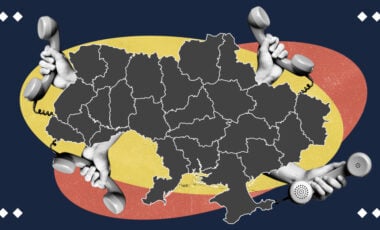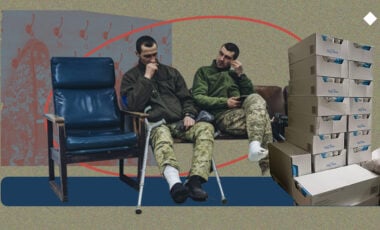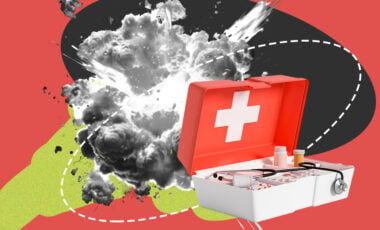Invisible front: how war affected domestic violence

By choosing their right to existence worthy of human dignity, Ukrainians encountered an abnormal amount of violence in 2022. Daily tragic news about the total leveling of the rights of people in captivity, temporarily occupied territories, and frontline regions are shocking. It changes the perception of the limits of human cruelty.
At the same time, dramatic figures with the number of victims of domestic violence have slowly disappeared from the media: what can this really indicate? We analyze in our material.
Although at first glance, it may seem that the smaller number of appeals regarding domestic violence dictates a positive dynamic, it is worth taking a closer look at the analysis of the work of specialized organizations, the workload of which has increased significantly with russia's full-scale invasion of Ukraine.
What does domestic violence statistics hide?
In the first half of 2022, there were 27.5% fewer reports of domestic violence to law enforcement agencies than during the same period in 2021. 773 documented cases in the first half of 2022 versus 1,508 for the same period in 2021, respectively. The YurFem analytical center provides such data in its report.
The decline in domestic violence referrals is directly correlated with war and access to the legal system. Lack of direct communication and emotional tension produce aggression and deepen conflicts that could have been resolved violently even before the invasion. Thousands of families have been forced to move to safer cities, but this does not guarantee women protection from the violent patterns familiar to their families.
Even when the victim is far from the perpetrator, which makes physical violence impossible, moral violence (for example, manipulation of children) or threats (banning taking children abroad) may occur. If the woman and the child are financially dependent on the man, you can often find cases of blackmail, which is classified as economic violence in a couple.
The situation with violence in the temporarily occupied territories, where neither the victims nor the Ukrainian law enforcement officers have access to the proper procedure for documenting and investigating the crime, is not under control.
It should be taken into account that even with contact with psychological assistance services, victims of violence cannot count on full support due to the occupation regime.
On February 25, 2022, the "Women's March" NGO launched a 24/7 psychological support hotline for Ukrainian women. A significant part of such appeals is about domestic violence.
Tetyana Pavlova, the coordinator of the hotline, says that she and her colleagues receive the most significant number of calls just after the liberation of the territories from the russian invaders.
"For many women, reporting domestic violence is a huge problem. Every day we send 3-4 women (from the hotline – ed.) to law enforcement agencies, but the big problem is that people do not agree to go there," Tetyana Pavlova says.
The psychologist emphasizes that domestic violence does not always happen between a man and a woman — sometimes, it happens between parents and children. For example, when teenagers are punished because they decide to go to university or even because they may eat too little/too much. According to Tatyana Pavlova, adult women often contact the hotline because of problems with their children, but then it turns out that their husband is a gaslighter manipulating the wife and devaluing her efforts to preserve and support the family.
Documenting wartime crimes is a long-term process that will continue even after the end of hostilities. That is why publicly available figures and percentages today are only a relative forecast of the real picture.
Why victims do not leave the abuser: "cycle of violence" and shelters
There is still a stereotype that it is easy to leave a relationship at once. According to Ms. Tatyana, only a few women can implement their plan to end an abusive relationship and start life on a new page on the first try. Most return to the abuser because of the fear of "independence." Especially during active hostilities. Having a home, a life, and a partner to whom they are accustomed (or being economically dependent on them), such women try to maintain a "normal life" and, as a result, face its illusory nature through frequently repeated incidents.
Usually, systematic aggressive behavior in the family gives rise to the so-called "cycle of violence," which every time forces the victim to return to the family and hope for a better future.
For example, after a quarrel ("explosion phase"), the partner becomes ashamed of their behavior; they make excuses and promises not to resort to violence and become caring ("honeymoon phase"). Sometimes couples try to pretend that the violent episode never happened. Over time, the offender again loses control over themself and returns to threats and humiliation (phase of "rising tension"), which eventually leads to relapse.
The agency against domestic violence in the USA, "Women Against Abuse," notes that, on average, a victim of domestic violence returns to the aggressor 7 times before finally leaving the relationship.
"Women between the ages of 14 and 62 apply to the psychological service of the "Women's March." The older a woman is, the less chance she has of leaving the abuser because fundamentally changing one's life is a rather resource-consuming challenge," Tetyana Pavlova shares.
Due to this, the relevant services can receive systematic appeals from one woman for a long time. Even if victims are offered specific steps to get out of a dangerous relationship, many factors stand in the way of a final decision.
"Approximately 10% of women, after contacting the "Women's March" hotline, turned to law enforcement agencies and/or left the abuser. Often these are young women who have not yet gotten used to living in violence for decades. At the same time, teenagers and young mothers usually simply have nowhere to go," the expert adds.
A logical step would be to rely on shelters for victims, which existed in every region even before the full-scale war. The public sector, like public services, assumes an important role as an agent in protecting victims. Often it is the representatives of public organizations, the police, and the ambulance that bring women to shelters. Daria Pylyo, a lawyer at the NGO "La Strada – Ukraine," shares the problems that potential residents of such shelters may face:
"Even before the introduction of martial law in the country, the issue of confidentiality of shelter addresses, which is done to protect the injured persons staying there, was relevant. But now the situation has changed because there are cases of placement of IDPs in shelters, search by perpetrators of injured persons who have left temporarily occupied cities."
How to protect yourself from domestic violence?
Article 126-1 of the Criminal Code of Ukraine clearly defines the types of violence and provides administrative and criminal liability for violators. The Istanbul Convention, which aims to prevent violence, protect victims, and solve the problem of impunity for criminals, should become a fundamental document that provides for a quick and effective response to victims' appeals.
However, Ukrainian realities, reinforced by active combat operations, prove that the current system is not ready for the number of appeals as of 2022 and sometimes even sabotages rapid response mechanisms.
"Coming to the police is one of the important stages on the way to prosecution. The main challenge was turning to the police in the temporarily occupied cities because there is a certain stigmatization, distrust of the population and hopelessness that the topic of domestic violence is irrelevant during the war," says Daria Pylyo, a lawyer at the NGO "La Strada – Ukraine."
In addition to the biased attitude towards police activities during the war, it is also worth noting that even in cases of real appeals, one cannot always count on timely and efficient assistance. For example, often, the police and an ambulance can be called only from the locality where the victim and the perpetrator are located.
Sometimes the appeals of victims can be transferred to "Polina" (a network of rapid response groups from the Ministry of Internal Affairs, which specializes in domestic violence). However, it is worth considering the number of "Polina" mobile groups (55) and the limited geography of their work (36 settlements). Tatyana Pavlova shares that once, an appeal to "Polina" in Dnipro was not accepted due to a lack of personnel, and the patrol police refused to respond to the call.
In August 2022, the information campaign of the UN Foundation against domestic and gender-based violence, "Break the Circle," launched 101 teams of social and psychological assistance to victims who survived violence and internally displaced persons who were forced to leave war zones. The geography of work of such brigades is twice as wide as that of "Polina." Still, the smallest number of these mobile rapid response groups is in the south and east of the country — in those regions where the level of insecurity from violence is the highest due to active hostilities.
In the same month, "Break the Circle," together with the National Police and the Ministry of Internal Affairs of Ukraine, launched an application that allows victims to call for help by holding down the application icon for a few seconds. Such a technological solution promises effective and, most importantly, safe assistance from the police and human rights organizations in critical situations.
But there are also such circumstances when the victim of violence does not have access to a telephone. Sometimes the "Women's March" hotline receives appeals from victims who write from a stationary computer, a phone of a friend, a relative, or even the same offender who could forcefully take the phone from the victim.
What does the Istanbul Convention solve?
On November 1, the Istanbul Convention entered into force in Ukraine — the fundamental agreement of the Council of Europe on combating violence against women and domestic violence.
However, it is the Istanbul Convention that formulates the types of offenses that Ukraine is obliged to criminalize from now on: psychological, sexual, and physical violence; persecution; forced marriage, abortion, sterilization; female circumcision.
Dmytro Lubinets, the Human Rights Commissioner of the Verkhovna Rada of Ukraine, published a list of measures aimed at protecting and supporting victims, including:
- application of protective orders;
- ensuring that victims are informed about their rights and opportunities for assistance and protection;
- ensuring the activity of specialized support services;
- not silencing the problem of domestic violence;
- protection and support of children who are witnesses of domestic violence.
In addition to the points listed, the Istanbul Convention will also strengthen information campaigns on violence prevention, initiate preventive intervention and treatment programs, encourage the creation of corporate policies on the prevention and detection of violence, and emphasize violence prevention in educational programs.
Because the Istanbul Convention has been ratified in 37 countries, Ukraine, in cooperation with international partners, will have the right to bring perpetrators to justice even abroad and also strengthen the protection of women who had to hide from the abuser on the territory of another state.
Already approved methods of combating violence are still criticized by some segments of the population, whose anti-gender rhetoric not only compromises human rights and entrenches gender stereotypes but also poses a real threat to victims of violence. The distorted perception of the main ideas and replacement of the concepts of the Istanbul Convention, which are still being promoted by right-wing radical and religious groups in Ukraine, gives a signal that domestic violence is still perceived as an acceptable phenomenon in some places and victims are subjected to social pressure after sometimes publicizing violent episodes from their traumatic experience.
The educational component mentioned in Articles 13, 14, and 15 of the Istanbul Convention will significantly affect the level of awareness and methods of interaction with victims of domestic violence. This will primarily apply to social workers and law enforcement officers and may eventually be incorporated into school plans. Thanks to such training, civil society is expected to become less prejudiced against various manifestations of all forms of violence and apply algorithms to prevent violence.
According to Kateryna Levchenko, the government commissioner for gender policy, the road map of legislative changes, created thanks to the analysis of compliance of the current legislation with the Istanbul Convention, should be approved shortly. In particular, it adjusts criminal responsibility for all types of violence (Chapter VI) and the organization of correctional programs for offenders (Article 16).
After the victory, Ukrainian men and women will rebuild the country and their families. During this period and in the future, the Istanbul Convention will protect victims of violence, help prevent repeated episodes of violence and apply appropriate punishment for offenders. The Istanbul Convention is a guarantee of the safety and well-being of Ukrainian women during the war and after its end.
The material was prepared by the NGO "Divchata" as part of the project "Providing emergency aid and protection services to the population affected by the conflict in Ukraine," implemented by Help – Hilfe zur Selbsthilfe in Ukraine with the financial support of the Federal Ministry of Foreign Affairs of Germany and NAK-karitativ. It does not in any way represent the official point of view of the donors.

























































